If you’re planning to visit the island of Zanzibar, it’s important to understand the tidal activity of the area. There are some beaches on the island where tides are barely noticeable, while in some places the water can recede very far during low tide. Thankfully, tides follow a predictable schedule so you can plan your holiday activities around the time when there are the best waves or the calmest waters. In this article, we will share which parts of the island are most affected by the changing tides, locations of the beaches you can visit that have little tidal changes, and fun things to do during the low tide, too.
How do tides in Zanzibar work?
Zanzibar is a popular vacation spot for tourists from all over the world. Zanzibar is featured on every “Top 10 Beaches of Africa” list for its pristine white sand beaches, excellent snorkeling, and developed tourist infrastructure. Nungwi beach is probably the world’s best-known Zanzibar resort spot. But what makes it a perfect getaway is not only the coral reefs and clear waters but also minimal tidal changes near the coastline. However, not every Zanzibar beach is as good in this regard.
The main island of the Zanzibar archipelago is named Unguja but more often it is simply called Zanzibar. The island stretches from north to east along the Tanzanian coast in the Indian Ocean. Tides are most noticeable on Zanzibar’s east coast, where the water line might move very far away from the beach, exposing the seabed for miles during the low tide. One such spot is Chwaka Bay.
In order to avoid disappointment, it is a good idea to learn a few basic things about the phenomenon of tides: how it works, what kind of schedules it follows, and how to choose the best location on Zanzibar for your trip. Understanding tides can help you choose the right resort or beach hotel during your vacation in Zanzibar and truly enjoy your trip. Now let’s continue exploring the secrets behind tides step by step.
What causes tides?
The nature of tides can be explained by the gravitational forces of celestial bodies, primarily the moon. The moon is the closest large object to the Earth and, therefore, it influences our planet the most. The Sun has a gravitational pull, too, although it is weaker than the moon’s pull due to the large distance. The highest tides occur during new and full moons when the gravitational forces of the moon combined with those of the Sun have the most influence on the earth’s oceans.
Thus, these lifts of water move along the planet's surface, rising and falling, lagging behind one another by approximately More precisely, 12 hours and 25 minutes pass between two high tides (as well as between two low tides), since the Moon makes a complete turn around the Earth in 24 hours and 50 minutes.
The time difference between the lowest water levels, which we call low tide, is also about 12 hours. So low tide and high tide are about six hours apart. Because the moon rises and sets a little later each day, the tides "shift". This interval and its changes can be seen on all tide charts. Keep this figure in mind if you are spending a holiday on the seashore: on tidal beaches, the water recedes the furthest just over six hours after the highest tide.
Actually, the moon pulls on everything on Earth, including water, the solid part of the Earth's shell, and even air. Tracking water fluctuations is the easiest for us because changes in surface heights are unnoticeably insignificant, while atmosphere fluctuations are indiscernible to the human eye
Tidal variations across the Earth
It is not only the moon and the sun that impact the ocean tides - water level fluctuations are also affected by specific features of our planet’s surface. The Earth isn’t actually a perfect sphere because it has protrusions of mountains and hills and depressions of seabeds, caves, etc. We may not see it like that, because water typically fills in the depressions, but solid rocks and geological obstacles cut off the way in some locations preventing flooding. Thus, the water level largely depends on the shore topography. That's why the distance to which water recedes varies drastically between neighboring beaches and sometimes even between the opposite ends of the same beach.
Moreover, the relationship between the water level and the moon’s gravitational pull is impacted by large masses of open water. The open ocean is most susceptible to tides, while in partially enclosed water areas such as the Baltic, Black, and Caspian Seas, the phenomenon of the tides is almost imperceptible.
In the middle of an ocean, the water rises only up to about a meter high, which is hardly visible to the eye, while on the coastline the difference between high and low tides can amount to a few meters, vertically measured. For example, the highest tides on Earth (as high as 59 feet / 18 meters) are reported at the Flowerpots Rocks in Canada’s Bay of Fundy.
Due to a combination of those factors, there is a large variability in tidal activity between different places where the sea meets the land. For example, the mean tidal range does not exceed 50 cm / 20 inches in the main part of the Caribbean Sea, while the average water rise in Zanzibar is 3-4 meters (10-15 feet) or more - a remarkable difference.
If you look at the features of Zanzibar’s coastal terrain and estimate the horizontal differences in coastal surface (instead of the water rise as such), you’ll notice the enormous variation between some of the beaches. On the west side of Nungwi beach at low tide, the water recedes only about 25 meters / 80 feet back, while on Chwaka and Charave beaches, seabeds get exposed for as far as 1.5-2 kilometers (0.9 to 1.2 miles) from the coastline.
Now that we sorted out the tidal theory, let's take a stroll along the beaches of Zanzibar and learn about tides at the most popular Zanzibar destinations.
Popular Zanzibar beaches by tidal strength rating
Geographically, Zanzibar is an archipelago comprising a few islands, the largest of them being Unguja Island - the major destination for most travelers. Most tourists congregate in Unguja and enjoy the hotels and beaches around its shores. For the sake of simplicity, we will use the name Zanzibar for Unguja, referring to the beaches of this island specifically.
You will find the majority of resort infrastructure on the northern and eastern coasts of Zanzibar, while the south-western part, where the airport, the ferry port, and popular destinations such as Stone Town and Prison Island are located, is populated by local residents. Zanzibar beaches are named after the nearest villages and can be roughly divided into the northern beaches, the eastern beaches, and the beaches of Chwaka Bay.
Northern coast: little tidal effect
The northern coast of Zanzibar experiences minor tidal effects on the coastline. As a result, the seabed is consistently full, which makes ocean swimming possible and pleasant throughout the day. It should not be a surprise that this feature made the northern part of Zanzibar the most attractive and expensive resort destination in the area. Here, you can find the widest variety of top-class hotels, numerous cafes, bars and restaurants, stores, and other facilities which make your vacation more convenient and comfortable. The northern coast is perfect for those who are looking for luxury, sunbathing, swimming during the day, and enjoying music and dancing in the evening. The developed tourist infrastructure also attracts local vendors who offer souvenirs, as well as a variety of other products and services.
Nungwi and Kendwa are the key northern destinations. Nungwi is allegedly the most famous of all the Zanzibar beaches, housing the greatest concentration of local attractions, such as Zoos and other facilities where you can see and interact with animals were conceived with the intent to show people the diversity of wildlife up close - however, in reality, such businesses infringe on the rights of animals, causing them suffering. Altezza Travel does not recommend visiting such establishments so as not to support wildlife-harming activities and businesses. For those who want to explore the world of wildlife, we highly recommend having a look at safaris in the protected national parks and advising the same to your friends and other travelers.
Kendwa is considered to be quieter and more luxurious, with fewer tourists compared to Nungwi. Families with children are also less likely to stay here than on Nungwi. When there is a low tide, a land passage between these two beaches appears, so if you time it right, you can walk from one to another and explore both, staying at a hotel nearby.
Tides are mostly insignificant on both Kendwa and Nungwi, and the entire Kendwa beach is swimmable throughout the day - while the northernmost Nungwi tip might "lose" its water to as far as 30 meters off in the west of the coast during low tide, and as far as 500 meters in its eastern part. Accordingly, this is also where the beach is most flooded at high tide.
Accommodations in Kendwa
On Kendwa, which is considered the beach with perfect tides, Altezza Travel recommends staying at Zuri Zanzibar hotel, whose name encapsulates the allure of the region - the Swahili word “zuri” is the particle that goes into the words describing all that is beautiful. Zuri Zanzibar features luxurious villas, comfortable bungalows, and exceptional suites, as well as the perfect beach in a lagoon nearby.
Accommodations in Nungwi
When it comes to Nungwi, Altezza Travel’s top choice is Essque Zalu Zanzibar Hotel, which is particularly beautiful in the evenings, when both the hotel and its pier are illuminated with myriads of lights. The pier also gives you a great advantage at low tide, when you can walk around and explore the exposed seabed with crustaceans crawling out of the sand and birds coming to feed on them.Eastern coast: moderate tides
The beaches on the eastern coast, excluding those in Chwaka Bay, are subject to noticeable but moderate tides. Here it is important to have a look at the tide chart and understand the schedule of high and low tides.
These are the northeast beaches: Kigomani, Matemwe, Pwani Mchangani, Kiwengwa, and Pongwe. Compared to the northern coast beaches, they are less popular as tourist destinations, so the infrastructure is not as developed. Families with small kids will probably be the first to notice a slight lack of attractions to keep their kids entertained. However, the northeastern coast is perfect for snorkeling and diving, especially if you take a boat to Mnemba Island. The waters of Mnemba are teeming with tropical fish that live around the beautiful coral reef, and according to many tourists, the clear waters of this little island resemble what one can see in the Maldives. Matemwe is considered one of the most secluded beaches, while Kiwengwa is the leading destination on the northeastern coast.
There are very beautiful and comfortable hotels in this part of the island, capable of taking the experience of vacationing in eastern Zanzibar to the highest level. Altezza Travel recommends staying at Xanadu Luxury Villas and Zanzibar White Sand Luxury Villas & Spa. The snow-white Xanadu Luxury Villas hotel, with its flower-bud-like villas and petal-roofed pool, stands by Dongwe beach. And next to Paje beach, filled with white sand, justifying its beautiful name, Zanzibar White Sand Luxury Villas & Spa welcomes its guests.
If you’ve seen the trendy Instagram photos of a restaurant on a rock surrounded by water, this is where it is located. We would not take up your time telling you about this restaurant here, but this location attracts much interest among tourists. While it’s certainly a big attraction for visitors, you must be aware of the tides in order to get that perfect photo of “The Rock Restaurant”. It looks best during high tide when the azure water splashes around the restaurant hut built on the rocks. In addition, the way you get to the restaurant itself at high tide is more interesting - you will need to take a boat across the beautiful water. At low tide, the sand around the restaurant rock is exposed, making it not as picturesque, but at least you can just walk to the restaraunt straight across the seabed.
On all eastern beaches, the low tide leaves a lot of seaweed on the sand as well as sea urchins. Sometimes sharp corals are exposed as well. So walking barefoot is not recommended here. In order to avoid injuring your feet, it's better to buy a pair of water shoes. Beware of the sea urchins - stepping on their spikes is really painful. Sea urchins are common on most beaches, and you might not even notice them when the active high tide makes the waters murky.
Chwaka Bay: biggest tides
Chwaka Bay has the biggest perceptible tides in Zanzibar. The topography of Chwaka Bay causes the low tide to significantly expose the seabed, forcing water off the shore as far as 1.5-2 kilometers, or up to 1.2 miles out on Chwaka and Charawe beaches. If you book a hotel in this area and do not plan to move around the island, the tide schedule here could affect how much you enjoy your Zanzibar vacation.
A little to the north of here you will find Uroa Beach. It is a little better when it comes to tidal fluctuations and tourist infrastructure. Another peculiarity of the beaches of Chwaka Bay is that they are used as farmlands for growing seaweed which is used in many soaps and high-end cosmetics. The locals set lots of stakes and poles across the beaches to grow laminaria, so you have to be careful when walking around the shore. At the same time, the Chwaka Bay beaches have the advantage of being the closest location to Stone Town if you want to explore this famous destination while still staying at a hotel on the beach. In fact, day tours are just the best thing to do while waiting for the high tide.
Other Zanzibar Beaches
Southern beaches
Some of the southern beaches - Mzambarauni, Kizimkazi Mkunguni, and Kizimkazi Dimbani, are similar in tidal activity to the beaches of the eastern coast. The southern Zanzibar locations are highly valued for their privacy and the top-notch level of hospitality at the hotels. Altezza Travel’s destination of choice on the southern coast is The Residence Zanzibar, where ensuring the best experience for the guests is the number one priority. Exclusive service is guaranteed by The Residence Zanzibar, which is a part of an international luxury resort chain.
Kizimkazi beaches are adjacent to Menai Bay and are home to Zanzibar's largest marine protected area, the Menai Bay Conservation Area (MBCA). MBCA was established to protect the habitats of indigenous fish and large marine mammals, particularly dolphins. The coastline is not as exposed here at low tide as on the east coast of Zanzibar.
From Kizimkazi, excursion boats go further out into the bay in search of dolphins. Boaters take tourists to bottlenose and humpback dolphins. So you have a chance to see these beautiful animals in their natural habitat and take pictures.
Stonetown beaches
Stonetown has its beaches as well, although the ones close to the pier are occupied by boats, and the more remote beaches are used by the locals. There is no guarantee that the ocean near Stonetown is not polluted by sewage waste, so tourists are not recommended to swim there. However, the tides aren't as pronounced in this part of the island.
Other west-coast beaches are typically unsuitable for tourists due to their modest size and poor accessibility. Transport infrastructure is underdeveloped in the areas far from the island capital, especially in the southern and western parts. Hotels and decent roads start to appear closer to Kendwa beach.
South of Kendwa there are mostly mangroves, tropical forests, high cliffs, and thin strips of land near the sea favored by fishermen. Admittedly, though, there is some fun in renting a car, discovering deserted beaches in western Zanzibar with minimal tides, and enjoying your own snatch of paradise.
Some hire boats in Stonetown and head to tiny islands nearby Unguja, like Sandbar Island, approximately 30 minutes from Stonetown, for a romantic ocean picnic. Keep in mind that such islands have no infrastructure at all, and the lack of tides on them is not guaranteed. A short boat trip to an islet can be a fun thing to do if you want to find a pristine empty spot for a photo shoot or try something different. The nearest island beaches are Nakupenda and Bave.
Things to do during low tide
Now, low tide is not a tragedy. Firstly, the water will return back soon, and you’ll be able to enjoy swimming and snorkeling again. What’s more, low tide is the perfect time to wander around the exposed seabed. The Indian Ocean itself has opened up for you! How often do we see such amazing natural phenomena?
The tide uncovers numerous starfish, crabs, and shells, and one can discover dozens of different sea creatures that remain on the sand as the ocean's blanket rolls away.
We remind you, however, that it is unethical to interfere in the lives of animals, even when it comes to the smallest and most beautiful ones. Moreover, it is forbidden to collect and take objects of flora and fauna home with you from the country of Tanzania. If you are spotted having shells from Zanzibar beaches at the airport customs authority, you may be fined or even detained. Altezza Travel supports and promotes the idea that in any encounter with nature, one should remain an observer - even when you are interacting with the tiniest wildlife on a tourist beach.
Families with young children benefit from tides most of all. Playing in the warm sand is safe and fun, but keep the kids protected from the sun using shade, sunscreen, and hats.
If it happens that the tide interferes with your swimming plans in the daytime, there is a host of other activities to enjoy:
-
go on a day trip to Stonetown to explore and shop for souvenirs or art,
-
visit Jozani Forest Reserve, which is home to the endemic red colobus monkey,
-
take a tour to the spices plantation,
-
enjoy a boat trip and see dolphins in Menai Bay or giant turtles near Prison Island,
-
take advantage of your accommodation’s swimming pool,
-
have a spa day and experience Zanzibar’s unique oils and treatments,
-
or simply explore other Zanzibar beaches.
Thankfully, the relatively compact size of Zanzibar and short distances between locations allow you to cross the entire island only in about 1.5 hour drive.
Alternatively, if you are willing to wake up extra early to catch the high tide for snorkeling or diving (especially around Mnemba Atoll), or enjoy a sunrise boat ride to see the dolphins around Kizimkazi, then you can spend the hours of low tide taking a wonderful nap under a beach umbrella.
Where can I find tide charts?
Hotels often have an information chart on both the weather and upcoming tides at nearby beaches. You can plan your vacation days in advance, taking into account the natural timing of tides.
It might come in handy to download and install a mobile app that helps you track the current water level and tides just by turning on your GPS or saving your current location manually.
Just google "tide schedule" to find a convenient website or mobile app and select your location (Tanzania, Zanzibar). You can choose the app you like most and keep track of the tide schedule.
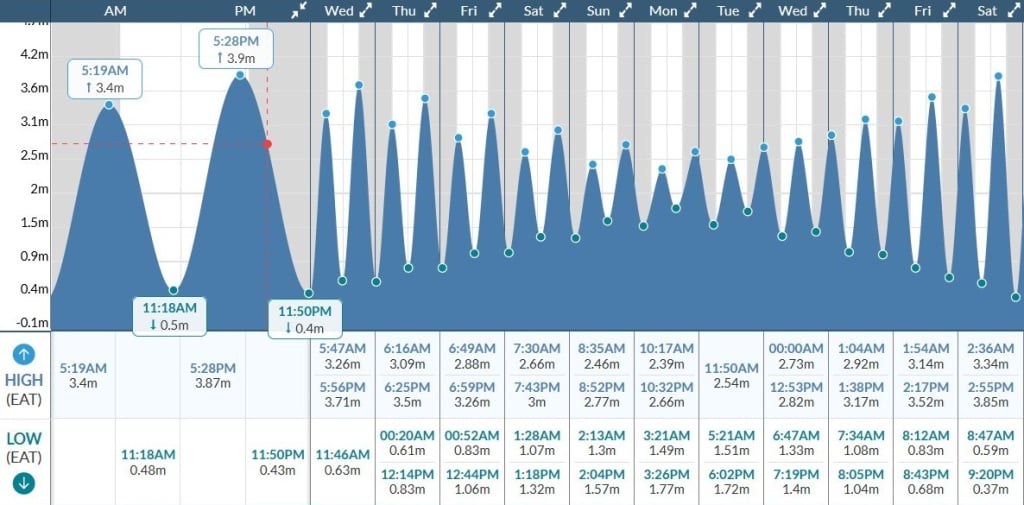
On the chart above, you can see a wave graph with coordinates for daily time and water level. As you remember, there are two high tides and two low tides in a day. Accordingly, the two peaks on the graph are the points of high tide, and the two lows are the low tides. Thus, the perfect time for swimming is at the top of the high tide peak on the chart, while the ideal time for walking, sunbathing, and excursions is below the tide midline. Note that the height of the tides is always different, so the water level at the same beach changes daily.
In the monthly schedule, you can see a table with dates and times. The box where they intersect indicates the height of the water rise. An excellent time to swim would be the 2-4 hours within the highest values, and the rest of the day is when the water recedes, leaving the seabed exposed until the next high tide. There might also be chart options where you can simply see four data point for a specific day: highest tide, lowest tide, high tide, low tide.
You can see on the charts that the time for each tide shifts forward by about 30-40 minutes daily. This is due to the difference between the daily rotation of the Earth around the Sun and the full revolution of the moon around the Earth. For example, on June 1, the highest point of the tide was at 5:15 p.m. On June 2, it shifted to 5:45 p.m. Once you get the basic principles of tidal activity, you can roughly predict the tides and plan your vacation easily.
We wish you a pleasant vacation on the beaches of Zanzibar! We hope you enjoy swimming in the warm waters of the Indian Ocean at high tide and take a nice stroll on the sand when the water recedes for a while.











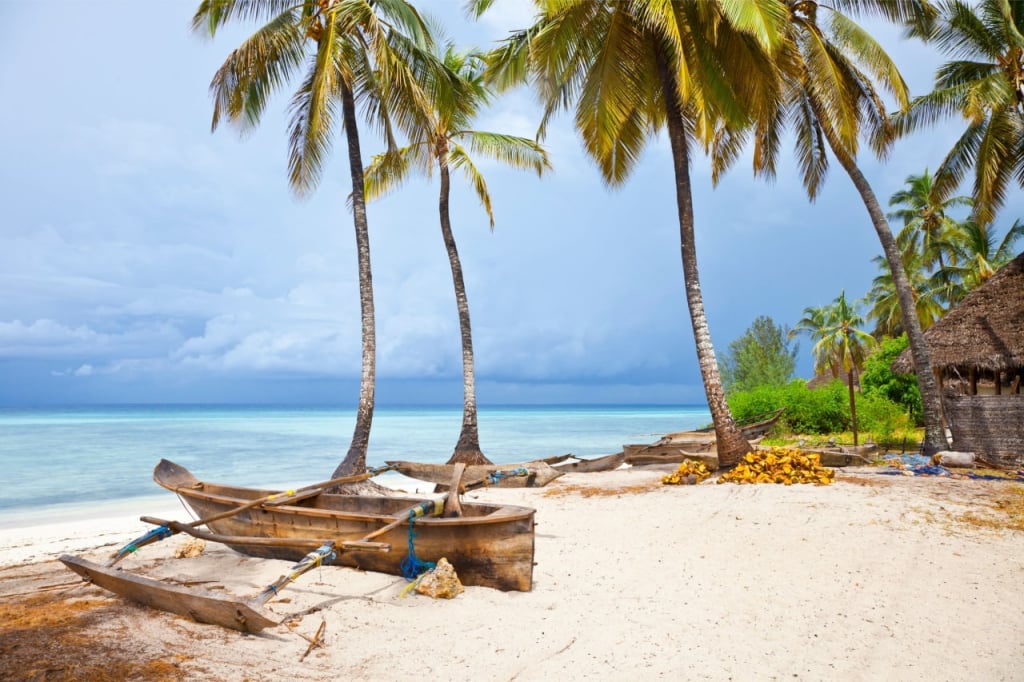
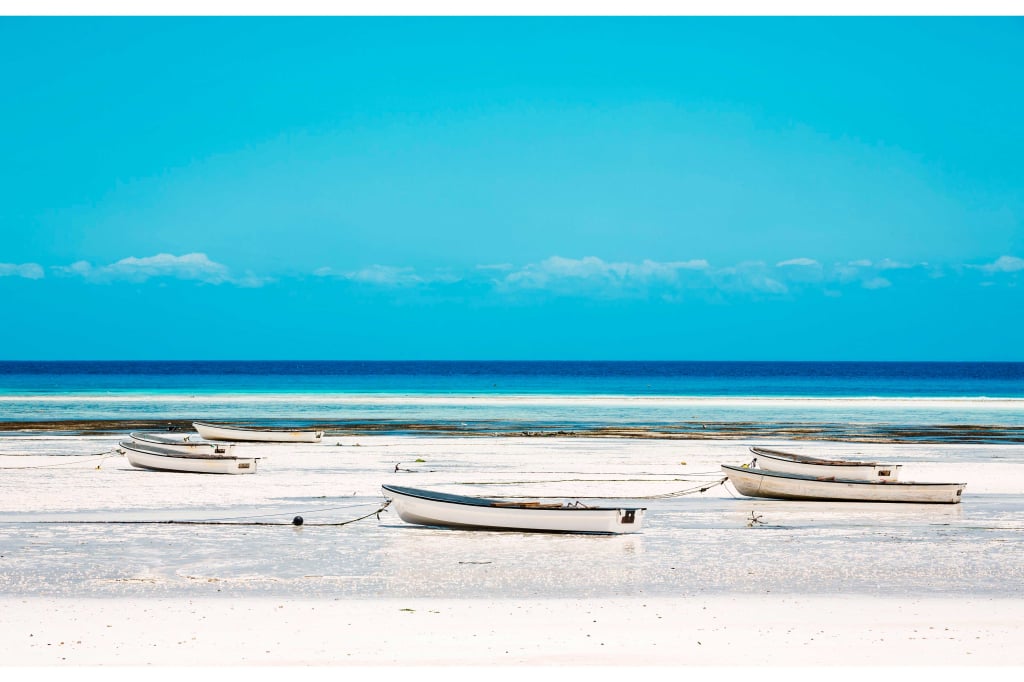
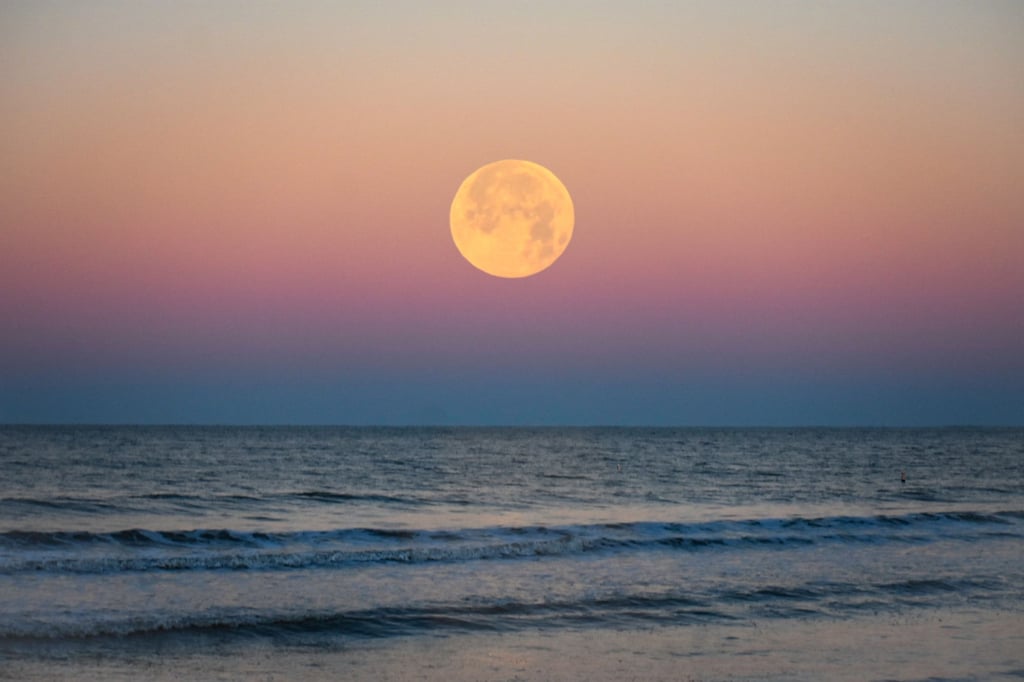
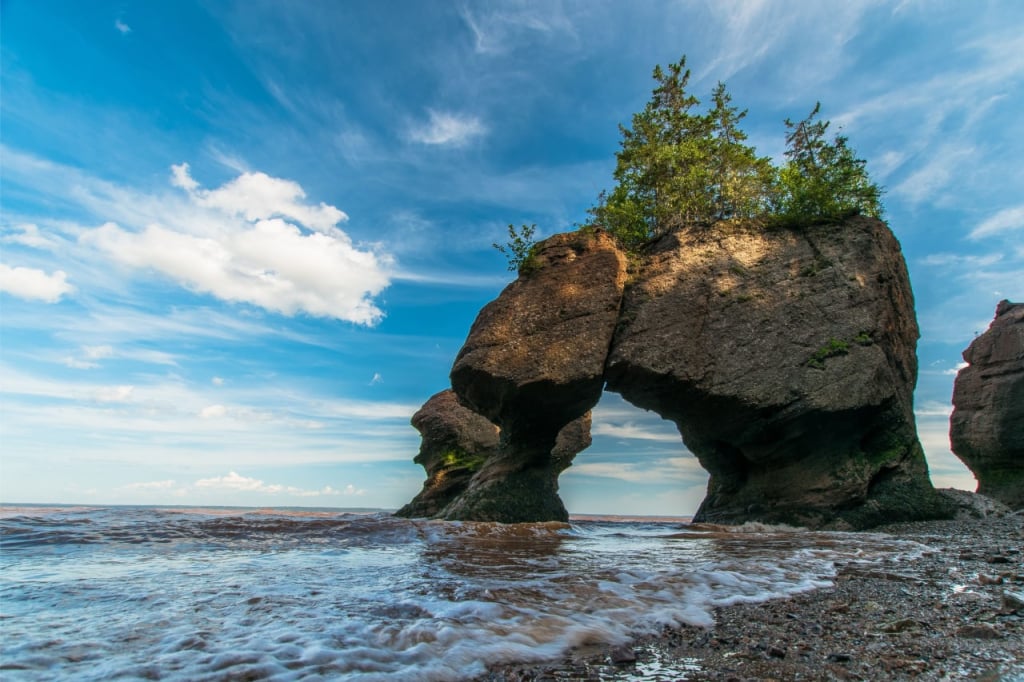

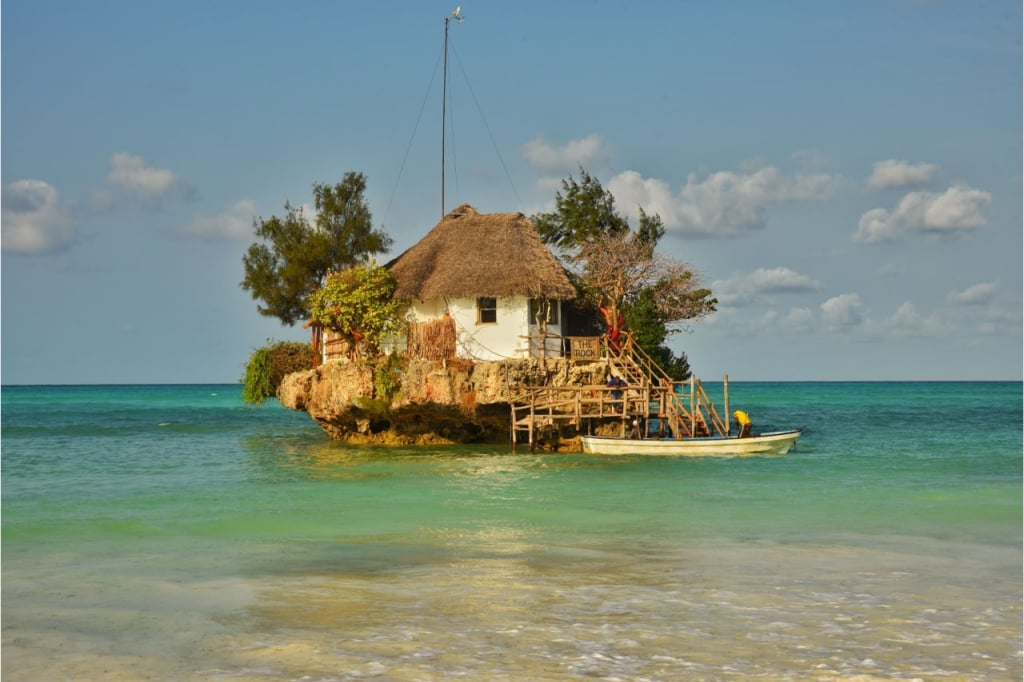
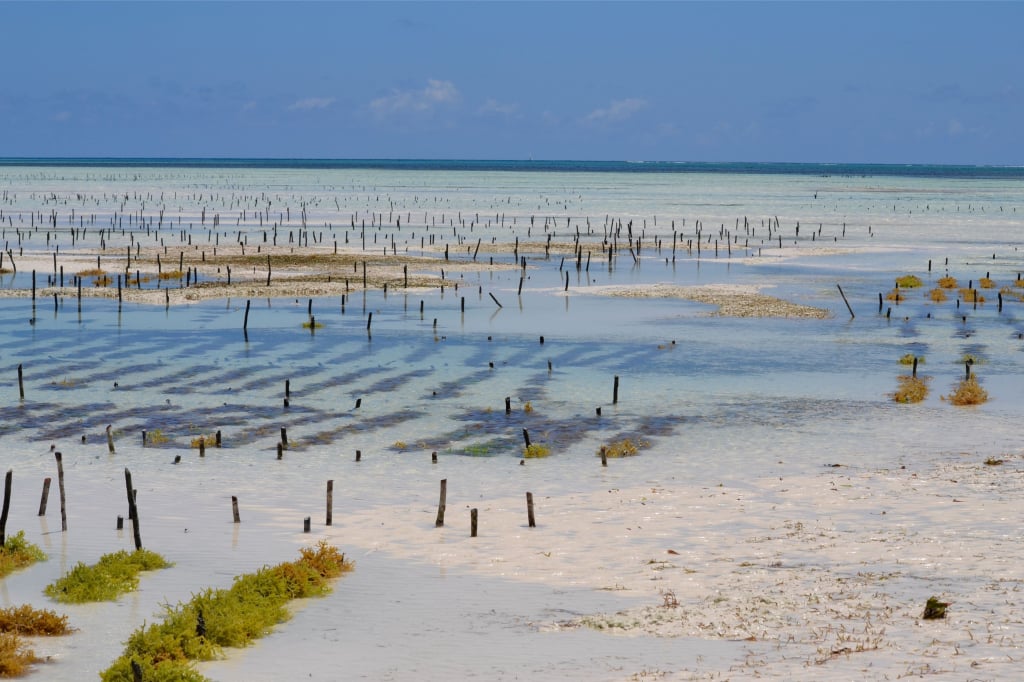

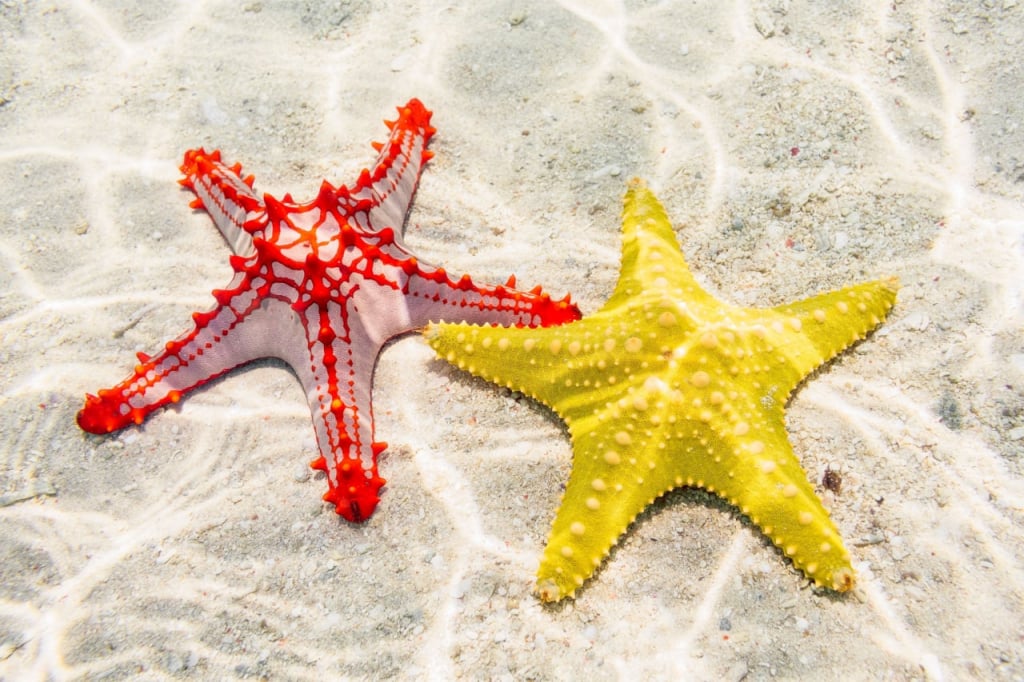
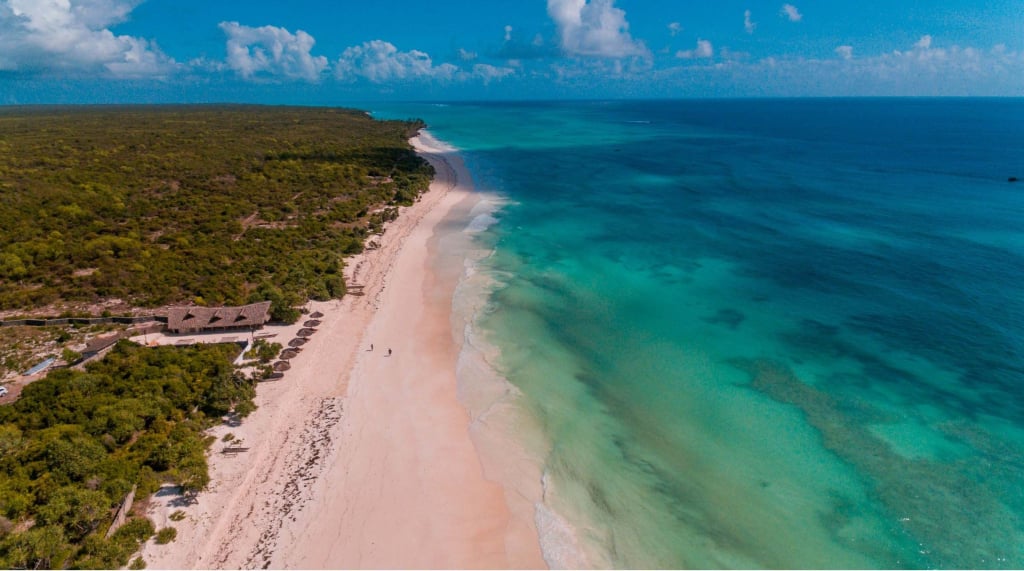




Is there a RIP current? Can it be dangerous to the tourists?
There are no rip currents on Zanzibar, but if you venture offshore for snorkeling or swimming, you need to be careful with the tides. During a full moon, the tides are significantly stronger.